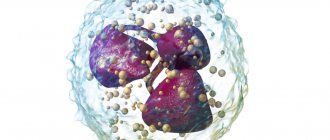Ascites is an excess accumulation of fluid in the abdominal cavity.
This is usually a symptom of liver damage (cirrhosis, etc.) or the development of malignant neoplasms in the abdominal organs, as well as the pelvis. In most cases, ascites is accompanied by other clinical manifestations of the underlying disease.
There are conservative and surgical methods for treating ascites. Laparocentesis is a surgical method.
Laparocentesis (another name is paracentesis) is a procedure in which a catheter is inserted into the abdominal cavity through a puncture in the abdominal wall.
Laparocentesis can be therapeutic and diagnostic. Therapeutic laparocentesis involves the evacuation of a significant volume of fluid and is used for severe ascites that is not amenable to conservative treatment. Diagnostic laparocentesis is performed to take fluid samples for analysis to identify or cause ascites, often used when it reoccurs. As a rule, therapeutic laparocentesis also includes a diagnostic component.
Causes of ascites
Normally, fluid is present in the abdominal cavity, but in small quantities. The accumulation of excess fluid (ascites) can be caused by various reasons, among which three volume groups can be distinguished.
- Ascites can be caused by hypertension (high blood pressure) in the portal vein, which collects blood from the abdominal organs, due to cirrhosis of the liver, toxic or viral hepatitis. This type of ascites is called portal ascites.
- Ascites can develop due to a malignant tumor (primary or metastatic) in the liver or other abdominal organs, metastatic lesions of the peritoneum, or Hodgkin lymphoma. This is malignant ascites.
- Cardinal ascites is associated with decompensation of cardiovascular diseases and is often accompanied by congestive heart failure.
9500 patients annually
- We accept patients 24/7
- Stabilization, resuscitation, medical care
Call me back!
There are other, less common, causes of ascites:
- peritonitis;
- pancreatitis;
- kidney damage;
- congenital anomalies and vascular diseases of the abdominal cavity;
- nutritional disorders and protein deficiency.
In 65-75% of all cases (according to various sources), the cause of ascites is liver cirrhosis. In 15-20% it is associated with heart disease and the appearance of malignant tumors. Other reasons account for 5-10%.
Recovery Tools
Medicines that reduce the effects of chemotherapy and restore health are prescribed individually for each patient, depending on the diagnosis and the cytostatic agent used. These can be either traditional pharmaceuticals or herbal ones.
Drug therapy is carried out in a hospital setting. Since the liver takes the first blow, it initially needs support. In this situation, the patient takes hepatoprotectors and enterosorbents.
After discharge, the patient is advised to radically change his lifestyle and diet. In most cases, rehabilitation takes about 4-6 months. Experts are developing programs to effectively cleanse the body and protect against attacks by pathogenic flora.
Our experts also recommend taking VIALIFE chlorophyll capsules, which will help minimize side effects in the shortest possible time due to the properties of the maximum possible dosage of chlorophyll in the composition.
Mechanism of development of ascites
In liver cirrhosis, ascites occurs due to changes in the structure of the organ. Connective tissue replaces normal tissue, and in scarred areas the vascular network is transformed. Due to compression of the veins by connective tissue nodes, a number of pathological processes develop, leading, in particular, to an increase in pressure and resistance in the portal vein. As the pressure in the portal system increases, increased filtration and sweating of the liquid part of the blood into the liver tissue begins to occur. This increases the volume of lymphatic drainage from the liver - the lymphatic system thus responds to an increase in the volume of tissue fluid. However, this does not give the desired effect during progressive cirrhotic processes, and fluid begins to leak from the surface of the organ into the abdominal cavity. This is how the so-called “crying liver” appears. The peritoneal layers can absorb only part of the resulting fluid, and as a result, it accumulates in the abdominal cavity.
Our expert in this field:
Moiseev Alexey Andreevich
Oncologist, Ph.D.
Candidate of Medical Sciences
Experience: More than 19 years
Call the doctor
Call the doctor
The process of ascites formation in heart diseases is very complex. The main role in this case is played by congestion in the systemic circulation and right ventricular failure.
Ascites in cancer
For cancer of the stomach, colon, pancreas, breast, uterus, and ovaries, especially in the later stages, ascites is a fairly common complication.
The immediate causes of development can be different:
- Blocking the outflow of the lymph nodes due to tumor damage to the lymph nodes;
- Damage by tumor cells to the peritoneum, a layer of connective tissue covering the internal organs and walls of the abdominal cavity;
- Damage to the liver, as a result of which albumin, a protein that maintains the oncotic pressure of the blood, ceases to be produced in the required amount;
- Increased pressure in the portal vein.
Ascites that develops against the background of oncology does not respond to conservative treatment. In these cases, only surgical methods can help - laparocentesis and peritoneal drainage. Sometimes additional surgical interventions are performed to prevent fluid from accumulating in the abdominal cavity in the future.
How to deal with the problem?
High blood pressure in oncology is often caused by disturbances in the structure of the organ due to the germination of its functional part by pathological tissue. Such changes in blood pressure can only be corrected etiotropically (by influencing the cause):
- if the vessels are compressed from the outside, surgical removal of the tumor mass or local radiation therapy is necessary, which will reduce the volume of the tumor;
- when the walls of blood vessels grow, blood pressure will be reduced by the elimination of cancer cells from the body (targeted or chemotherapy, radiation);
- if the kidney parenchyma is affected by metastases, they must be excised or reduced in size as much as possible in a conservative way;
- in case of a brain tumor it is necessary to remove it;
- if endocrine organs are affected, medications that block the effects of hormones will provide temporary relief.
High blood pressure can be caused by hormonal treatment of a tumor (for example, prostate cancer).
In turn, low blood pressure in oncology is characterized by changes caused by the indirect influence of the tumor and arrosive bleeding. Oncologists prescribe symptomatic treatment (drugs to increase blood pressure, hemostatic agents), but this is a temporary measure that supports the patient’s life while preparing for surgery.
Types and clinical picture
There are minimal, moderate and severe ascites, or its three degrees.
Grade I ascites has no clinical manifestations. It can only be diagnosed using ultrasound, CT or laparoscopy. The amount of fluid in the cavity is slightly higher than normal.
Stage II ascites is characterized by the accumulation of a large amount of fluid and, accordingly, an increase in the abdomen in size, but no obvious stretching of the tissue is observed.
With grade III ascites, the stomach becomes huge and the figure becomes clearly disproportionate. There are difficulties in movement and breathing. The volume of fluid accumulating in the abdominal cavity can be 15-25 liters.
The most common complications and unpredictable reactions
Sometimes antitumor therapy has such a severe toxic effect on the body that the quality of life becomes worse than during the disease. This may be accompanied by the following symptoms:
- changes in taste, loss of appetite, nausea, vomiting;
- weakness not associated with physical activity, dizziness, drowsiness;
- muscle pain, neuropathy (numbness of the hands, feet);
- depressed state, panic attacks;
- decreased cognitive abilities – deterioration of memory, concentration;
- bowel disorder - diarrhea or constipation;
- increased body temperature;
- hair loss, change in color of nail plates and skin;
- swelling, redness, ulceration in the mouth area;
- in men – loss of libido and erection, reproductive functions; in women – failure of the ovaries.
Weakened immunity and an increased risk of bleeding are directly related to changes in blood composition, namely a drop in the number of neutrophils and platelets. After such destructive symptoms that do not go away on their own, recovery from chemotherapy for oncology will be required.
The WHO classification considers several degrees of severity of side effects:
- 0 – no changes in condition and laboratory tests are observed;
- I – recording of minor deviations that do not affect the general condition and do not require correction;
- II – moderate changes in internal organs, noticeable deterioration in test data and decreased activity. The patient needs therapeutic assistance;
- III – severe violations requiring the cancellation of sessions and mandatory intensive somatic treatment;
- IV – changes in the body that pose a threat to human life.
Methods for treating ascites
As mentioned at the beginning of the article, there are conservative or surgical treatments for ascites.
With conservative treatment, diuretics are prescribed to help remove excess fluid from the body. It is mandatory to monitor the amount of fluid you drink, daily urination and body weight. The patient should minimize salt intake, as it retains water in the body.
Send documents by email The possibility of treatment will be reviewed by the chief physician of the clinic.
Among the methods of surgical treatment, laparocentesis is the most common. The operations of Kalb, Ruott and others are also used. The fluid outflow paths in their case are formed somewhat differently, but these procedures also imply the direct removal of accumulated fluid.
The choice of treatment method for ascites depends on its degree, cause, general condition of the patient, additional complications, etc.
Our clinic's capabilities
Is there really no way to mitigate the effect of anti-cancer drugs? - thinks every sane person. Of course it is possible, but the whole point is that this will reduce not only the toxicity, but also the therapeutic effect of chemotherapy.
Recently, photodynamic therapy has been increasingly used in the treatment of cancer. PDT is a technology proven by more than twenty years of successful practice. Selective chronophototherapy (SCPT), which is based on photodynamic therapy, is capable of activating a cascade of biochemical and cellular reactions to regulate the level of immune status indicators. A special substance is introduced into the body - chlorophyll (a natural photosensitizer of the latest generation), which accumulates in cancer cells. A laser beam is sent to the site of accumulation, capable of synchronizing with the patient’s rhythms, which makes it possible to reduce or increase the intensity of the effect. Penetrating to the required depth, it concentrates on pathological cells, destroying them, without touching healthy ones. Over the course of several months, the tumor disintegrates.
PDT is used not only to remove tumors, but also instead of chemotherapy, unlike which it does not have a destructive effect on the body. The manipulation can be performed on an outpatient basis.
How is laparocentesis performed?
Laparocentesis is performed under local anesthesia. The patient is in a semi-sitting or sitting position. Using a special instrument (trocar), which is a metal tube and a triangular needle inserted into it, a puncture is made in the abdominal wall. Then the needle is removed and the accumulated liquid is evacuated through the tube. The amount of fluid evacuated during one procedure is determined by the doctor.
To avoid injury to the intestines, laparocentesis is performed under ultrasound guidance. Or they use special devices with the help of which a space is created in the abdominal cavity free of intestinal loops.
Laparocentesis allows not only to remove fluid from the abdominal cavity, but also, if necessary, to find out the exact cause of the development of ascites through analysis of the composition of the fluid.
If long-term removal of fluid is necessary, then a drainage tube connected to a special container is installed for this purpose, but a more modern solution is peritoneal port systems. This is a titanium reservoir sewn under the skin and connected to the abdominal cavity with a catheter. One of the walls of the tank is a membrane made of a special material. To evacuate the liquid accumulated in the reservoir, it is enough to pierce the skin and the membrane under it with a needle. Thus, the port system creates much less inconvenience for the patient, being completely under the skin, and avoids regular laparocentesis procedures.
Prevention of pressure surges in a patient with oncology
The following tools will be useful:
- minimizing nervous shock (relatives should learn to provide information about the course of the disease);
- dietary restrictions (the daily amount of salt should not exceed 5 g);
- fluid intake up to 1.5 liters per day;
- exclusion of substances that excite the nervous system: alcohol, coffee, strong tea, nicotine.
If necessary, the doctor will prescribe maintenance drug therapy.
Preparation for laparocentesis
Laparocentesis is preceded by a standard set of studies, including:
- general chemical and biochemical blood test;
- coagulogram;
- general chemical urine analysis;
- tests for HIV, hepatitis B and C, syphilis;
- Ultrasound, which in this case is used to determine, among other things, the amount of fluid in the abdominal cavity.
A computed tomography scan may be prescribed. Immediately before the procedure, a cleansing enema is given, and it is also necessary to empty the bladder to avoid the risk of damaging it during the puncture of the abdominal wall.
If it is planned to remove a large volume of fluid, infusions of saline are given to fill the vascular bed with fluid.
Comprehensive monitoring
Laboratory research:
- general blood and urine tests;
- blood biochemistry;
- glycated hemoglobin to track average sugar levels over the past 3 months;
- thyroid profile with indicators of the level of thyroid hormones and specific immunoglobulins;
- insulin check;
- checking the homocysteine value;
- lipid profile with determination of fats of different fractions in blood serum;
- vitamin D content;
- checking the value of the iron-containing protein ferritin.
Consultations with a gynecologist, urologist-andrologist, and dentist are also scheduled. Hardware diagnostics: fluorography of the chest organs, ultrasound. Patients who have crossed the 40-year mark will have to additionally visit the following offices:
- for women - mammography, densitometry (detection of bone fragility);
- for men - ultrasound of the prostate gland, PSA (laboratory marker of the condition of the prostate gland);
- for both sexes - ECG, colonoscopy, coagulogram, duplex scanning of the thickness of the intima-media complex of the carotid artery.
Contraindications
Almost all contraindications for laparocentesis are relative. With the necessary preparation with the correction of the patient’s complications or compliance with conditions taking them into account, the procedure can be performed.
Such contraindications include:
- decreased platelet level (less than 20 × 103 / μl) (can be corrected by platelet transfusion before laparocentesis);
- bleeding disorders (corrected by infusions of fresh frozen plasma);
- adhesions in the abdominal cavity;
- cellulitis of the anterior abdominal wall;
- intestines dilated due to accumulation of gases;
- full bladder;
- pregnancy.
An absolute contraindication for laparocentesis is only an acute abdomen, which requires emergency surgery.
Possible complications
After laparocentesis, hematomas may remain on the abdominal wall and discharge from the puncture site may be observed. Possible in theory
- intestinal damage;
- infection;
- bleeding due to damage to a large blood vessel;
- decreased blood pressure, dizziness, fainting (with simultaneous evacuation of too much fluid);
- dysfunction of the liver and kidneys.
However, if the procedure is performed by experienced specialists with proper training, complications during laparocentesis are extremely rare.
conclusions
Cancer patients often suffer from low blood pressure. It is caused by exhaustion of the body, the development of hidden arrosive bleeding and the toxic effect of cancer cells.
Hypertension develops against the background of a neoplastic process when a tumor grows into the walls of blood vessels and compresses their lumen from the outside. In mild cases of the disease, it is absent. Increased blood pressure is typical for tumors of the adrenal glands, pituitary gland, and thyroid gland.
Low blood pressure is only one of the symptoms of the cancer process. Temporary drug correction is possible, but the most effective will be to reduce the tumor mass in the body.











